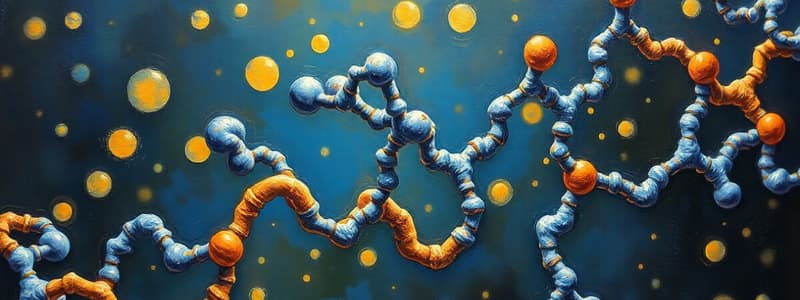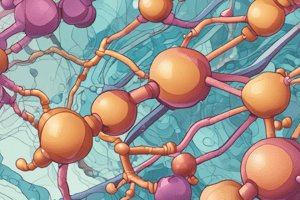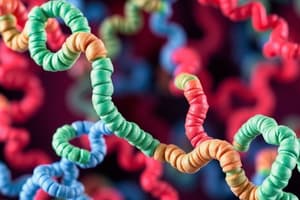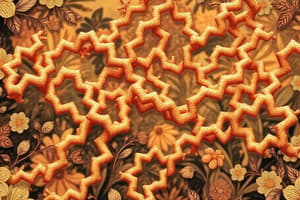Podcast
Questions and Answers
Describe the process by which amino acids are linked together to form a dipeptide, including the specific type of reaction involved.
Describe the process by which amino acids are linked together to form a dipeptide, including the specific type of reaction involved.
Amino acids link via a condensation reaction where an amino acid + amino acid forms a dipeptide + water. This process involves the formation of a peptide bond.
Explain what it means for the genetic code to be 'degenerate' and discuss its implications for protein synthesis and mutations.
Explain what it means for the genetic code to be 'degenerate' and discuss its implications for protein synthesis and mutations.
The genetic code is degenerate because multiple codons can code for a single amino acid. This allows for silent mutations, where a change in the DNA sequence doesn't alter the amino acid sequence of the protein.
Describe the roles of transcription and translation in protein synthesis, clarifying the specific molecules involved in each process.
Describe the roles of transcription and translation in protein synthesis, clarifying the specific molecules involved in each process.
During transcription, DNA is transcribed into mRNA. During translation, the mRNA is translated into a sequence of amino acids.
How do hydrophobic interactions influence the tertiary structure of a protein, and where do these interactions typically occur within the protein molecule?
How do hydrophobic interactions influence the tertiary structure of a protein, and where do these interactions typically occur within the protein molecule?
Describe the difference between essential and non-essential amino acids, explaining how each type is obtained by the human body.
Describe the difference between essential and non-essential amino acids, explaining how each type is obtained by the human body.
Explain how changes in pH can lead to protein denaturation, detailing the specific types of bonds that are affected by these pH variations.
Explain how changes in pH can lead to protein denaturation, detailing the specific types of bonds that are affected by these pH variations.
Describe the role R-groups play in determining the chemical diversity of amino acids, and provide two examples of how specific R-group properties affect protein structure or function.
Describe the role R-groups play in determining the chemical diversity of amino acids, and provide two examples of how specific R-group properties affect protein structure or function.
Distinguish between the primary, secondary, and tertiary structures of proteins, explaining what determines each level of structure and how they relate to each other.
Distinguish between the primary, secondary, and tertiary structures of proteins, explaining what determines each level of structure and how they relate to each other.
What are the roles of hydrogen bonds in the formation of the secondary structure of a protein?
What are the roles of hydrogen bonds in the formation of the secondary structure of a protein?
Describe how ionic bonds are formed within proteins, and explain how changes in pH might affect these bonds.
Describe how ionic bonds are formed within proteins, and explain how changes in pH might affect these bonds.
What role do disulfide covalent bonds play in stabilizing protein structures, and between which amino acid residues do these bonds typically form?
What role do disulfide covalent bonds play in stabilizing protein structures, and between which amino acid residues do these bonds typically form?
Explain the quaternary structure of proteins, including how it is formed and why it is important for protein function. Provide an example of a protein that exhibits quaternary structure.
Explain the quaternary structure of proteins, including how it is formed and why it is important for protein function. Provide an example of a protein that exhibits quaternary structure.
Describe the difference between conjugated and non-conjugated proteins, providing an example of each type and explaining the role of the non-protein component in conjugated proteins.
Describe the difference between conjugated and non-conjugated proteins, providing an example of each type and explaining the role of the non-protein component in conjugated proteins.
Globular proteins are soluble in water and play roles in transporting and regulating. Give an example of a globular protein and indicate how hydrophobic interactions contribute to its 3D structure.
Globular proteins are soluble in water and play roles in transporting and regulating. Give an example of a globular protein and indicate how hydrophobic interactions contribute to its 3D structure.
Describe the difference between globular and fibrous proteins, focusing on their structure, solubility, and primary functions.
Describe the difference between globular and fibrous proteins, focusing on their structure, solubility, and primary functions.
Explain how the structure of insulin (hydrophilic exterior and hydrophobic interior) facilitates its function in the bloodstream.
Explain how the structure of insulin (hydrophilic exterior and hydrophobic interior) facilitates its function in the bloodstream.
Explain how the sequence of amino acids in a polypeptide chain determines the protein's ultimate three-dimensional structure.
Explain how the sequence of amino acids in a polypeptide chain determines the protein's ultimate three-dimensional structure.
Explain the role of haem in haemoglobin's function, and describe how the interactions between haemoglobin's subunits contribute to its oxygen-carrying capacity.
Explain the role of haem in haemoglobin's function, and describe how the interactions between haemoglobin's subunits contribute to its oxygen-carrying capacity.
How do conditions such as high temperature cause a protein to denature?
How do conditions such as high temperature cause a protein to denature?
What is the role of the four substructures of haemoglobin? What could occur, if any of those substructures weren't held together by non covalent bonds?
What is the role of the four substructures of haemoglobin? What could occur, if any of those substructures weren't held together by non covalent bonds?
Flashcards
Proteins
Proteins
Complex macromolecules composed of one or more chains of amino acids.
Amino acids
Amino acids
The monomers used to make proteins that are covalently bonded to a central alpha carbon.
Condensation reaction
Condensation reaction
A reaction where amino acids join together, forming a dipeptide and releasing water.
Essential amino acids
Essential amino acids
Signup and view all the flashcards
Genetic code
Genetic code
Signup and view all the flashcards
Polypeptide
Polypeptide
Signup and view all the flashcards
Denaturation
Denaturation
Signup and view all the flashcards
Primary structure
Primary structure
Signup and view all the flashcards
Secondary structure
Secondary structure
Signup and view all the flashcards
Tertiary structure
Tertiary structure
Signup and view all the flashcards
Quaternary structure
Quaternary structure
Signup and view all the flashcards
Conjugated proteins
Conjugated proteins
Signup and view all the flashcards
Globular proteins
Globular proteins
Signup and view all the flashcards
Fibrous proteins
Fibrous proteins
Signup and view all the flashcards
Study Notes
Fundamentals of Amino Acids
- Proteins consist of complex macromolecules in chains of amino acids
- Amino acids are the monomers that make proteins
Amino Acid Structure
- The alpha carbon is covalently bonded to four chemical groups
- The four chemical groups are:
- Carboxyl group COOH
- Amino group NH2
- Hydrogen atom H
- R group (unique side chain)
- There exists 20 amino acids with different R groups.
Condensation Reactions
- Amino acids join via condensation: amino acid + amino acid -> dipeptide + water
- Additional amino acids bond to the dipeptide through peptide bonds
- Chains of amino acids are called polypeptides
Dietary Requirements for Amino Acids
- Two types exist: essential and non-essential
- Essential amino acids cannot be produced and must be consumed
- Non-essential amino acids are produced by the body
Protein Structure and Genetic Code
- Genetic code rules translate DNA information into amino acid sequences for proteins
- Instructions for protein synthesis happen through transcription and translation.
- DNA is transcribed to mRNA, which then translates to a sequence of amino acids.
- Codons, groups of three nucleotides, specify amino acids or a stop signal
- With 64 codons for 20 amino acids, the genetic code is degenerate allowing silent mutations
- Combining 20 amino acids creates limitless proteins with diverse structures/functions
- The genetic code generates diverse combinations of amino acids, creating a diversity of life
Polypeptides
- Polypeptides are amino acid chains linked by peptide bonds
- Proteins are made of one or more polypeptide chains
- A protein with one polypeptide folds into a functional structure
- Proteins with multiple polypeptides interact to form the protein's overall structure
- Myoglobin is an example: an oxygen-binding protein in muscle tissue that stores and releases oxygen
Effects of pH and Temperature
- Denaturation is when a proteins structure is altered
- Denaturation can result in a loss of function
- pH and temperature cause denaturation
- Proteins function best within specific temperature and pH ranges
- Altered pH shape and high temperature break weak hydrogen bonds
R Group Diversity
- R-groups can be hydrophobic (repel water) or hydrophilic (attract water)
- R-groups can be acidic (negative) or basic (positive)
Primary Structure
- Primary protein structure is the specific amino acid sequence in a polypeptide chain
- Unique amino acid sequences determine how the polypeptide chain folds
Secondary Structure
- Refers to local folding patterns within the polypeptide chain
- Common patterns include alpha helices and beta-pleated sheets
- Hydrogen bonds between carboxyl and amino groups facilitate folding into coils and pleats, stabilizing the structure
Tertiary Structure
- Refers to the further folding of the polypeptide
- Stabilized by hydrogen bonding between polar R-groups, this stabilizes its 3D shape and maintains the protein's functional integrity
- Ionic bonding between oppositely charged ions also helps
- Forming ionic bonds
- Disulfide covalent bonds between cysteine amino acid residues stabilizes tertiary and quaternary structures
- Hydrophobic interactions are present between nonpolar amino acids, clumping together in the interior to minimize contact with water
Polar and Non-Polar Amino Acids Effects
- Hydrophilic polar amino acids orient towards the outside
- Hydrophobic non-polar amino acids are shielded inside minimizing interactions with water
- Myoglobin and haemoglobin are globular proteins with hydrophobic cores
- Integral proteins have hydrophobic amino acids, embedding them in membranes
Quaternary Structure
- Arrangement and interaction of two or more polypeptide chains to form a functional protein
- Haemoglobin: two alpha and two beta chains
- Haemoglobin is a conjugated protein because it contains haem
- Haem contains iron, binds oxygen in the lungs, and transports it through the body
- Haemoglobin subunits are held together by non-covalent bonds and allow conformational changes for oxygen transport
Conjugated and Non-Conjugated Proteins
- Consist of polypeptide sub units called non-conjugated
- Proteins: collagen, insulin
- Conjugated proteins contain non-protein components that increase diversity and functionality
Globular and Fibrous Proteins
- During protein folding, a polypeptide chain adopts a specific 3D shape
- The process involves hydrogen bonding, ionic bonding, and hydrophobic interactions
- Proteins are classified as globular or fibrous after folding completes
- Globular proteins are spherical, water-soluble, and involved in transport/regulation
- Insulin (alpha and beta chains with hydrogen, hydrophobic, and disulphide bonds) is an example
- The exterior structure of insulin are hydrophilic, and the interior is hydrophobic, needing to travel through the bloodstream.
- Fibrous proteins are long, narrow, and insoluble, providing support and stability in tissues.
Collagen Structure
- Collagen is a fibrous protein
- Made of three polypeptide chains
- Chains are twisted in a triple helix
- Each chain is rich in glycine and proline
Studying That Suits You
Use AI to generate personalized quizzes and flashcards to suit your learning preferences.



